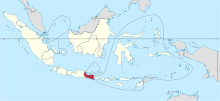
The Special Region of Yogyakarta is a provincial-level autonomous region of Indonesia in southern Java. It is a semi-enclave that is entirely surrounded by Central Java to the west, north, and east except for a long coastline of the Indian Ocean to the south.

Nusantara is the Indonesian name of Maritime Southeast Asia. It is an Old Javanese term that literally means "outer islands". In Indonesia, it is generally taken to mean the Indonesian Archipelago. Outside of Indonesia, the term has been adopted to refer the Malay Archipelago.
A regency, sometimes incorrectly referred to as a district, is an administrative division of Indonesia, directly under a province and on the same level with city (kota). Regencies are divided into districts.

Nagasari is a traditional Indonesia steamed cake, originating from Javanese cuisine, made of rice flour, coconut milk and sugar, filled with a slice of banana and wrapped in banana leaves.

Sukabumi Regency is a regency (kabupaten) in southwestern Java, as part of West Java province of Indonesia. The regency seat is located in Palabuhan Ratu, a coastal district facing the Indian Ocean. The regency fully encircles the administratively separated city of Sukabumi. Covering an area of 4,145.70 km2, the regency is the largest regency in West Java and the second largest regency on Java after the Banyuwangi Regency in East Java. The regency had a population of 2,341,409 at the 2010 census and 2,725,450 at the 2020 census; the official estimate as at mid 2022 was 2,806,664, with a large part of it living in the northeastern part of the regency that encircles Sukabumi City, south of Mount Gede. A plan to create a new regency, the North Sukabumi Regency is currently waiting for the approval of the central government.

The Salakanagara Kingdom is the first historically recorded Indianised kingdom in Western Java. The kingdom existed between 130-362 AD. Claudius Ptolemaeus wrote about Java in his book, Γεωγραφικὴ Ὑφήγησις. He mentions the lands of Chryse and Argyre in Labadio. According to some historians, e.g. Edi S. Ekajati, Labadio means Dwipa-Javaka, Dwipa-Javaka or Java Dwipa, which is the ancient name of Java Island. At the time, the Salakanagara kingdom ruled west Java and its name means “Silver Nation” in old Sundanese language. According to some theories, Ptolemaeus may have visited Java in 160 AD. A more recent source, from the 17th century, Pustaka Rajya Rajya i Bhumi Nusantara describes Salakanagara as being founded by an Indian merchant from Pallava Kingdom.
This is a list of some of the regions of Indonesia. Many regions are defined in law or regulations by the central government. At different times of Indonesia's history, the nation has been designated as having regions that do not necessarily correlate to the current administrative or physical geography of the territory of the nation.
Njoo Kiem Bie was a male badminton player from Indonesia in the 1950s. His biggest achievement was helping to bring the Thomas Cup to Indonesia for the first time, as a doubles player in the 1958 series in Singapore, and helping to defend that title in 1961 in Jakarta.

The Simalungun people are an ethnic group in North Sumatra, considered one of the Batak peoples. Simalungun people live mostly in Simalungun Regency and the surrounding areas, including the city of Pematang Siantar, an autonomous city, but previously part of Simalungun Regency.
Akhudiat was an Indonesian poet, playwright, and humanist.

Cangkuang is a small 8th-century Shivaist candi located in Kampung Pulo village, Cangkuang, Kecamatan Leles, Garut Regency, West Java, Indonesia. The temple is one of very few Hindu-Buddhist temples discovered in West Java, other temples include Batujaya and Bojongmenje temple.

Sumedang Larang is an Islamic Kingdom based in Sumedang, West Java. Its territory consisted of the Parahyangan region, before becoming a vassal state under the Mataram Sultanate.

The Lampung or Lampungese are an indigenous ethnic group native to Lampung and some parts of South Sumatra, Bengkulu, as well as in the southwest coast of Banten. They speak the Lampung language, a Lampungic language estimated to have 1.5 million speakers.
Prabhu Natha Girindrawardhana Dyah Ranawijaya was the ruler of the Majapahit Empire between 1474 and 1498. He is referred in a Jiyu inscription as Sri Wilwatikta Jenggala Kediri, which means ruler of Majapahit, Janggala and Kediri, and as Pa Bu Ta La in Chinese literature.

Mpu Tantular Museum is a State Museum located in Buduran, Sidorajo, East Java, a province of Indonesia. Formerly the Stedelijk Historisch Museum Soerabaia, the museum began as a society established by Godfried Hariowald von Faber in 1933. Today, the museum was the State Museum of the Province of East Java "Mpu Tantular".
In Indonesian law, the term "city" is generally defined as the second-level administrative subdivision of the Republic of Indonesia, an equivalent to regency. The difference between a city and a regency is that a city has non-agricultural economic activities and a dense urban population, while a regency comprises predominantly rural areas and is larger in area than a city. However, Indonesia historically had several classifications of cities.

Dra. Augustine Magdalena Waworuntu, was an Indonesian politician who became the first post-federal Indonesian mayor of Manado and the first female mayor of Manado.
Cirebon Sundanese is a variety of conversation in Sundanese in the ex-Residency of Cirebon and its surroundings, which includes Kuningan, Majalengka, Cirebon, Indramayu and Subang as well as Brebes in Central Java.
Sosrodiningrat V was a nobleman within the Surakarta Sunanate, serving as its pepatih dalem between 1939 and 1945. He was also a member of the Investigating Committee for Preparatory Work for Independence.













